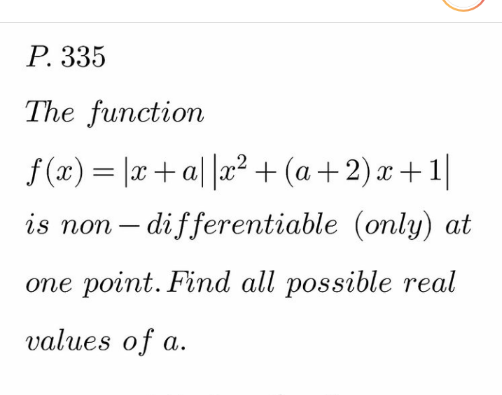Question Number 165164 by mnjuly1970 last updated on 26/Jan/22

Answered by aleks041103 last updated on 27/Jan/22
![f(x)=∣(x+a)(x^2 +(a+2)x+1)∣ for this to be non−diff at only one point we need (x+a)(x^2 +(a+2)x+1) to change signs only once. Since one always exists at x=−a, we need x^2 +(a+2)x+1 to not have real roots or to have exactly one with algebraic multiplicity of 2 or one of the roots of x^2 +(a+2)x+1 to coincide with the root of x+a, i.e x=−a. ⇒D=(a+2)^2 −4≤0 ⇒a(a+4)≤0 a∈[−4,0] or (−a)^2 +(a+2)(−a)+1=0 a^2 −a^2 +1−2a=0 ⇒a=0.5 then the other roots of f(x) are −0.5,−2,−0.5, which makes for one change in sign. ⇒Ans. a∈[−4,0]∪{(1/2)}](https://www.tinkutara.com/question/Q165179.png)
$${f}\left({x}\right)=\mid\left({x}+{a}\right)\left({x}^{\mathrm{2}} +\left({a}+\mathrm{2}\right){x}+\mathrm{1}\right)\mid \\ $$$${for}\:{this}\:{to}\:{be}\:{non}−{diff}\:{at}\:{only}\:{one}\:{point} \\ $$$${we}\:{need}\:\left({x}+{a}\right)\left({x}^{\mathrm{2}} +\left({a}+\mathrm{2}\right){x}+\mathrm{1}\right)\:{to} \\ $$$${change}\:{signs}\:{only}\:{once}.\:{Since}\:{one}\:{always} \\ $$$${exists}\:{at}\:{x}=−{a},\:{we}\:{need}\:{x}^{\mathrm{2}} +\left({a}+\mathrm{2}\right){x}+\mathrm{1} \\ $$$${to}\:{not}\:{have}\:{real}\:{roots}\:{or}\:{to}\:{have}\:{exactly}\:{one} \\ $$$${with}\:{algebraic}\:{multiplicity}\:{of}\:\mathrm{2}\:{or}\:{one} \\ $$$${of}\:{the}\:{roots}\:{of}\:{x}^{\mathrm{2}} +\left({a}+\mathrm{2}\right){x}+\mathrm{1}\:{to}\:{coincide} \\ $$$${with}\:{the}\:{root}\:{of}\:{x}+{a},\:{i}.{e}\:{x}=−{a}. \\ $$$$\Rightarrow{D}=\left({a}+\mathrm{2}\right)^{\mathrm{2}} −\mathrm{4}\leqslant\mathrm{0} \\ $$$$\Rightarrow{a}\left({a}+\mathrm{4}\right)\leqslant\mathrm{0} \\ $$$${a}\in\left[−\mathrm{4},\mathrm{0}\right] \\ $$$${or} \\ $$$$\left(−{a}\right)^{\mathrm{2}} +\left({a}+\mathrm{2}\right)\left(−{a}\right)+\mathrm{1}=\mathrm{0} \\ $$$${a}^{\mathrm{2}} −{a}^{\mathrm{2}} +\mathrm{1}−\mathrm{2}{a}=\mathrm{0} \\ $$$$\Rightarrow{a}=\mathrm{0}.\mathrm{5} \\ $$$${then}\:{the}\:{other}\:{roots}\:{of}\:{f}\left({x}\right)\:{are} \\ $$$$−\mathrm{0}.\mathrm{5},−\mathrm{2},−\mathrm{0}.\mathrm{5},\:{which}\:{makes}\:{for} \\ $$$${one}\:{change}\:{in}\:{sign}. \\ $$$$\Rightarrow{Ans}.\:{a}\in\left[−\mathrm{4},\mathrm{0}\right]\cup\left\{\frac{\mathrm{1}}{\mathrm{2}}\right\} \\ $$
